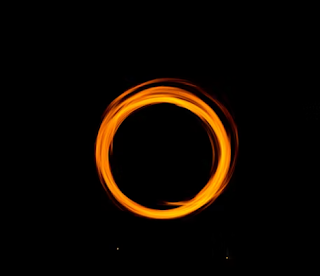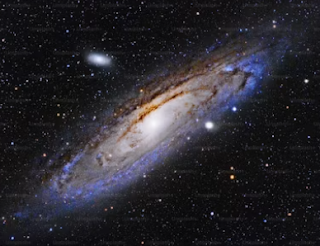Are black hole real ?
Though frequently portrayed in science fiction, black holes are a verified scientific reality. Because of their strange and intense character, these mysterious creatures grab the attention of scientists and the general public alike. Let's explore the definition of black holes, the evidence for their existence, and their place in the universe.
What is a Black Hole?
Definition
A black hole is an area of space where
light cannot escape due to the strength of the gravitational attraction. There is an enormous amount of mass concentrated in a relatively small area, which produces this incredible gravitational force. The event horizon is the point on a black hole's perimeter beyond which nothing can escape.
When enormous stars reach the end of their life cycles, they collapse under the force of gravity, creating black holes. When the star runs out of nuclear fuel, its core implodes, resulting in this collapse. A black hole is formed when the residual core collapses into a singularity, or point of infinite density, if its mass is greater than a particular threshold.
Evidence Supporting the Existence of Black Holes
The velocity of stars close to galaxy centers provides one of the most compelling arguments in favor of black holes. As an example, stars in the Milky Way's core move in a way that suggests they are being affected by a very large, unseen object. Most people think that this object is a supermassive black hole.
Gravitational Waves
Gravitational waves were first discovered in 2015 by the Laser Interferometer Gravitational-Wave Observatory (LIGO). Two black holes collided and merged, causing these rippling effects in spacetime. By demonstrating how black holes affect spacetime, this ground-breaking finding directly demonstrated the existence of black holes.
X-ray Emissions
The X-rays released by hot gas being
drawn into black holes can also be used to identify them. Space telescopes may
see the gas's high temperatures and X-ray emissions as it spirals inward. One
important clue to the existence of a black hole is its X-ray emission.
The Event Horizon Telescope (EHT) team published the first black hole image in history in 2019. The image displays the black hole's shadow at the center of galaxy M87, encircled by a hot gas ring that glows. It was a huge accomplishment for astrophysics when the event horizon of a black hole was visually confirmed.
Theoretical Foundations
General Relativity
The General Relativity equations by
Albert Einstein naturally give rise to the idea of black holes. These equations
predict that a black hole will arise when a large star runs out of nuclear fuel
and is unable to withstand gravitational collapse.
According to Einstein's calculations,
space and time would distort to the point where a black hole would develop in
specific circumstances. Numerous observations and experiments have confirmed
the existence of black holes, supporting these theoretical predictions.
The remains of huge stars that explode
as supernovae give rise to black holes. A stellar-mass black hole is created
when the remnant core collapses due to its own gravity if it is massive enough.
GrowthBy absorbing mass from theirsurrounds, black holes expand. This can happen by taking in material from a companion star in a binary system, merging with other black holes, or consuminginterstellar gas. A black hole's mass can increase dramatically over time.
Types of Black Holes
Stellar-Mass Black Holes
These black holes, whose masses range
from a few to tens of solar masses, are created when enormous stars collapse.
Intermediate-Mass Black Holes
The masses of intermediate-mass blackholes, which typically range from hundreds to thousands of solar masses, fallbetween those of stellar-mass and supermassive black holes. Research on theirformation mechanisms is still ongoing.
Supermassive Black Holes
Supermassive black holes are locatedat the centers of most galaxies, including the Milky Way. Their masses rangefrom millions to billions of solar masses. They are essential to thedevelopment and evolution of galaxies.
Galactic Centers
The majority of galaxies are home to
supermassive black holes. They play a major role in the formation and evolution
of galaxies through their gravitational influence on star orbits and gas
dynamics in their host galaxies.
Quasars and Active Galactic Nuclei
Extremely bright objects known as
quasars and active galactic nuclei (AGN) are powered by a portion of black
holes. Supermassive black holes radiate enormous amounts of heat and light when
material falls into them, creating quasars and AGNs among of the universe's
brightest objects.
Black Holes and Time Dilation
Theory of General Relativity
Time dilation can be brought on by a
black hole's strong gravitational field, according to Einstein's Theory of
General Relativity. This indicates that, in comparison to a position further
away, time moves more slowly close to a black hole.
Time Dilation's Impacts Close to Black Holes
Though it has gained popularity in science fiction, the time dilation
effect is a genuine, quantifiable phenomenon that relativity predicted. The
warping of spacetime around a black hole is so great that, from the perspective
of an observer far away, time for an item near the event horizon appears to
practically stop.
Exploring Black Holes: Current and Future Research
Gravitational Wave Astronomy
An exciting new age in astronomy has begun with the observation of gravitational waves. These waves are still being detected by observatories like LIGO and Virgo, which provide light on the characteristics of black holes and the circumstances surrounding their genesis and mergers.
Space Telescopes
Black hole research depends heavily on space telescopes like the James Webb Space Telescope (JWST) and the Chandra X-ray Observatory. By observing the high-energy X-rays released as matter falls into black holes, they aid in the understanding of the mechanics of accretion and the surroundings of these mysterious objects by astronomers.
Future Missions
The goal of upcoming projects such as
LISA (the Laser Interferometer Space Antenna) is to find low-frequency
gravitational waves originating from the merger of supermassive black holes.
These missions will shed more light on these cosmic giants and deepen our
understanding of them.
Black holes do
exist. There is little question regarding the existence of theoretical
predictions when they are supported by strong observational data. They continue
to be among the most fascinating topics in astrophysics, offering understanding
of the underlying principles of nature and the behavior of matter in harsh
environments. Our knowledge of black holes will surely continue to grow as
science and technology develop, revealing even more about these mysterious
things.
What happens if you fall into a black hole?
You would undergo spaghettification—acondition in which tidal forces bend you into an elongated, thin shape—if you fell into a black hole. At the singularity, where the gravitational force isendlessly powerful, you would ultimately be crushed.
How are black holes detected?
Black holes are detected by theirgravitational pull on nearby objects, X-rays released by hot plasma fallinginto them, and gravitational waves resulting from black hole mergers.
Can black holes destroy Earth?
No, black holes cannot destroy the Earth. The nearest known black hole is too distant to have any effect on our world.
How big can a black hole get?
Black holes can range in size from a
few to billions of solar masses, with the largest believed to be supermassive
black holes at galaxies' centers.
What is inside a black hole?
The innards of a black hole, beyond
the event horizon, is little known. It is thought to contain a singularity, a
point of infinite density where the known rules of physics fail.








